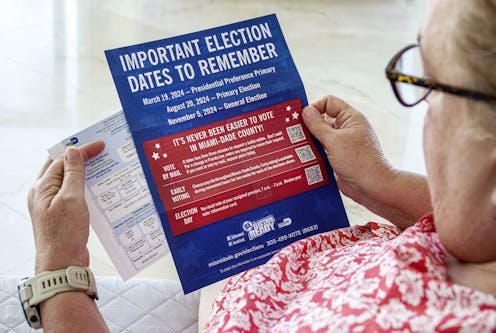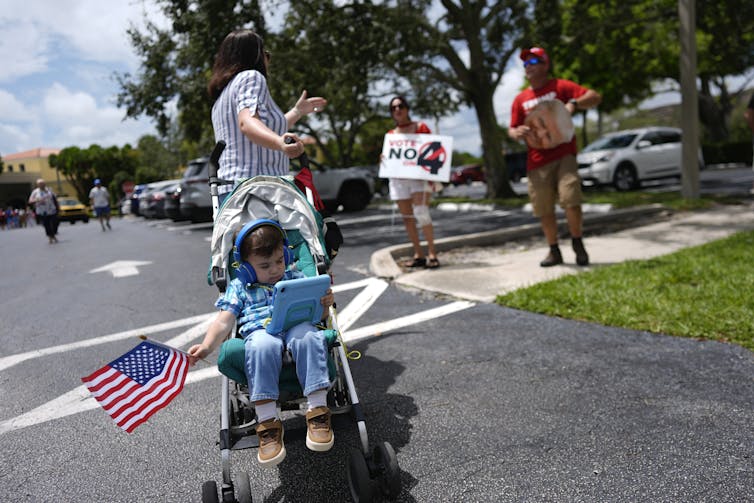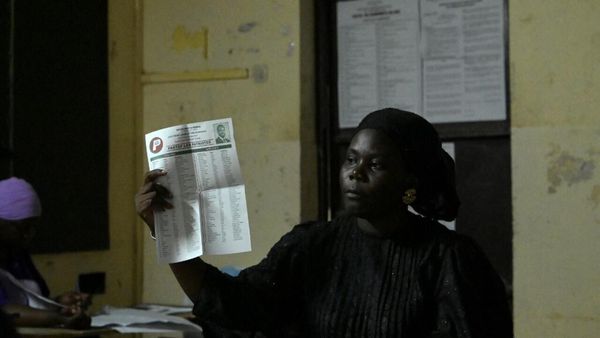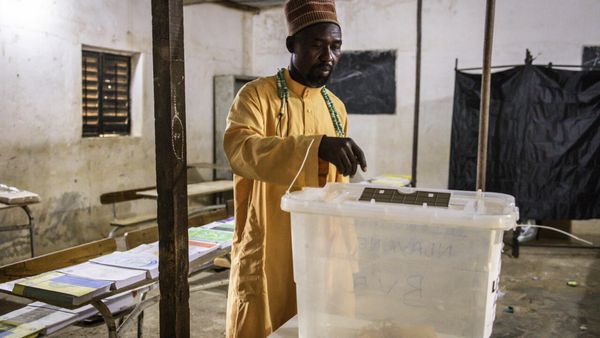
The number of voters registered as Democrats has tumbled in recent years in Florida, effectively removing the Sunshine State as a battleground and placing it firmly in the red column.
At least that’s the dominant narrative found in many media outlets. And it is true that Republican Donald Trump won the state in both 2016 and 2020.
Still, Nikki Fried, the Florida Democratic party chair, thinks Florida Democrats are making a “clear resurgence.”
Buoyed by broad support for two statewide initiatives on the ballot – the legalization of recreational marijuana and the establishment of a constitutional right to abortion up to viability – Fried is predicting robust turnout of Democratic voters this November despite concerns hurricanes Helene and Milton may suppress turnout.
Fried suggests that Democratic presidential nominee Vice President Kamala Harris and Democratic U.S. Senate nominee Debbie Mucarsel-Powell will benefit from the two hot issues on the ballot. A ban on most abortions after six weeks went into effect in Florida on May 1, 2024, with the state Supreme Court at the same time deciding to put the issue to voters.
The marijuana ballot measure looks likely to pass, while support for the abortion access measure is more uncertain. But the point is that these are the types of issues that bring Democrats – and unaffiliated voters – out to the polls.
I’ve written extensively on direct democracy and Florida politics. My research shows how ballot measures can have what I call “educative effects,” not only bolstering turnout but also priming voters to choose candidates who support the same initiatives they do.
This goes a long way to explain Republican Gov. Ron DeSantis’ efforts to thwart both measures, going so far as to use taxpayers’ dollars to oppose the abortion amendment.

Active voters
But Fried and the Democrats face a major hurdle – a widening voter registration gap – as Florida Republicans are quick to point out. Over the past several years, the GOP steadily narrowed the Democratic Party’s lead in voter registrations in the Sunshine State, finally surpassing Democrats’ plurality of active registered voters in 2021.
Fried thinks the widening gap between registered Republicans and Democrats is a mirage. She claims that the Republican advantage is an artifact of a shift in state law that more aggressively reclassifies voters as being “inactive” if they don’t vote in two general election cycles or keep their information on file with local supervisors of elections.
There is no question that the law, which went into effect in 2022, has deflated Democratic registration numbers. Here are the stats.
According to the Florida secretary of state’s website, updated on Oct. 7, 2024, there are more than 1 million more registered Republicans (5,455,480) than Democrats (4,400,561) in Florida, followed by no party affiliation (3,584,982) and those registered with minor parties (404,890). That is, Republicans appear to account for more than 39% of registered voters in the Sunshine State, while Democrats make up less than 32%.
However, the numbers posted on Florida’s official website, which amount to nearly 13.7 million registered voters, are misleading: They tally only active voters in the state.
There are more than 2.5 million inactive voters on the rolls as of Aug. 1, 2024, according to my calculation of publicly available raw voter files. This brings the total number of registered voters in Florida to more than 16 million people.
Inactive and unaffiliated voters
Inactive registered voters have every right to cast ballots just like active voters. The main difference between the two groups is that inactive voters didn’t vote in 2020 or 2022.
There are hundreds of thousands more inactive Democrats and unaffiliated voters than Republicans on the rolls. This is likely the result of lackluster campaigns in the state for Democratic presidential candidate Joe Biden in 2020 and for Democratic gubernatorial candidate Charlie Crist in 2022. Uninspired Democrats and unaffiliated voters didn’t show up to the polls, particularly in 2022.
Currently, according to the publicly available Florida voter rolls, there are over 900,000 inactive Democrats and over 921,000 inactive unaffiliated voters, compared with fewer than 643,000 inactive Republicans. So, while Republicans account for 39% of active voters, they account for only 25% of inactive voters.
To sharpen the point: 1 in 10 Republicans are currently inactive, whereas nearly 2 in 5 of all registered Democrats and more than 1 in 5 unaffiliated voters in Florida are inactive. These inactive voters tend not to receive the same attention from parties and groups trying to mobilize registered voters to the polls.
There’s no question that the fortunes of the Florida Democratic Party have tumbled over the past decade. Twelve years ago, just prior to the 2012 general election, Democrats accounted for 40% of all active registered voters. It’s been a sharp decline down to 32%.
But the difference has not been made up by Republicans. From 2012 to 2024, the share of active voters registered as Republicans increased by only 3 percentage points, from 36% to 39%.
The biggest increase in the share of active voters over the same period is with unaffiliated voters, whose share jumped 5 percentage points, from less than 21% in 2012 to 26% in 2024. These unaffiliated voters in Florida tend to be younger and Hispanic, many of whom likely have been turned off by the toxic political landscape in the state.
But back to the November election and Fried’s prognostications.
Will the two statewide ballot measures – Amendment 3 on recreational marijuana and Amendment 4 on reproductive rights – offset the rise in Republican voter registration in Florida? Is the sizable lead of Republican active voters a mirage, only to disappear as Election Day nears?
It will come down to turnout and whether inactive Democratic and unaffiliated voters’ support for Amendment 3 and Amendment 4 primes them to back the Democratic ticket.
Daniel A. Smith does not work for, consult, own shares in or receive funding from any company or organization that would benefit from this article, and has disclosed no relevant affiliations beyond their academic appointment.
This article was originally published on The Conversation. Read the original article.







